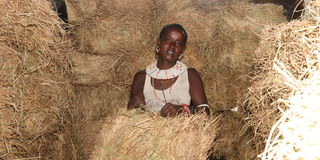Samburu farmers turn to haymaking to secure livelihoods

Nouyam Leapora, 36, at the Lookere Nalepo Group hay store in Nakwamur village in Samburu East.
What you need to know:
- The pastures take approximately three months to mature fully so locals start harvesting both grass and even seeds.
- Once cut, the grass is dried under the sun before being compacted into bales - precious reserves of feed that will sustain livestock through the dry seasons.
Nouyam Leapora's face is slick with sweat as she wraps bales of dry hay and stacks them inside a makeshift structure. The crackle of dry hay fills the air as she bundles it under the sweltering heat of Nakwamur village, deep in Samburu East.
“It scratches my skin while I work, but I don’t mind,” Nouyam says, wiping the sweat from her face. “These bales are making a big difference in our lives.”
Nouyam is part of the Lookere Nalepo Group, a collective of pastoralists who have turned to pasture farming—a new venture that contrasts sharply with Samburu County's history of cattle raids, and the looming threat of climate change that has resulted in perennial droughts in the region.
In Nakwamur, three acres of land owned by the group are dotted with golden stacks of hay, a stark contrast to the surrounding parched landscape. For the Samburu people who have traditionally been semi-nomadic, this shift represents a significant cultural change.
“We’ve always moved with our herds, searching for fresh grazing fields and water. But with droughts and cattle rustling on the rise, we needed a new way to survive,” says Royman Lolpuranai, a 27-year-old member of the group.
The introduction of pasture farming is more than just a new agricultural practice for the community; it’s a step towards securing a stable future.
“When drought hits, we lose our livestock, which is our only source of livelihood. But this initiative gives us hope,” Lolpuranai explains.
The group received training from USAID Nawiri and was provided with grass seeds to kickstart the project. Locals have also learned to prepare the land in semi-circular bands, which help prevent soil erosion.
The chosen grass, African Foxtail (Cenchrus ciliaris), thrives in Samburu’s harsh climate and matures in about three months.
"The semi-circular, moon-shaped bands help prevent the soil erosion common in this region help prevent soil erosion which is prone here. We have mastered the techniques," Lolpuranai says.
The pastures take approximately three months to mature fully so locals start harvesting both grass and even seeds. Once cut, the grass is dried under the sun before being compacted into bales - precious reserves of feed that will sustain livestock through the dry seasons.
The dry bales are then stored in temporary structures for use during the drought. The group also agreed to sell surplus bales to farmers in neighbouring villages and even towns, including Archers Post and Isiolo.
"For me, this is a huge relief that is reducing the burden of walking long distances to avert losses and also improve food security," he says.
Pastoralists had witnessed a massive decline in livestock productivity due to limited access to pasture and water points, and as a result, reproductive rates among cattle, goats, and sheep plummeted.
This also caused a decline in herd sizes and milk production, and effects like malnutrition were evident.
But, the little that survived are now growing healthy and milk is in plenty following the availability of pastures, according to Mr Lolpuranai.
The hay-making process has now become a daily routine for locals and has substituted the trekking that pastoralists do to feed and quench their animals.
Besides improving nutrition, in a region where cattle theft has long been a source of conflict, the availability of locally produced hay has helped to reduce the need for raids, according to former Waso East Senior Chief Gabriel Lenyakopiro.
The former local administrator says that more reliable access to pasture often reduces the desperation that usually drives young men (morans) to steal from neighbouring communities.
He says that the pasture production process is becoming vital in ending insecurity and malnutrition that affects the majority of locals in Samburu.
"Scramble for pastures is the core source of conflicts in this region. When you produce your own, it reduces the encounter with herders who often fight to access natural pastures," says Mr Lenyakopiro.
"Livestock are now healthier thanks to consistent feeding and are providing better milk yields and more meat," he adds.
Nelly Leparie, USAID Nawiri, Natural Resource Management and Peace Building Officer says pasture production projects are vital in alleviating malnutrition by ensuring the availability of high-quality forage, especially during the dry season when most livestock migrate to distant grazing areas.
She says the access to nutritious fodder improves livestock health, enhancing their body condition and reproductive performance, which in turn boosts the nutritional, social, and economic value of the herd to households.
"By conserving and storing fodder during peak seasons, we ensure a reliable supply for milking herds during the dry months, providing essential milk for children under five. This approach significantly contributes to reducing persistent acute malnutrition in Samburu," says Ms Leparie.
This has a direct impact on the nutrition and well-being of the Samburu people, who can now rely on their animals for sustenance even during the driest months.
Prolonged droughts, unpredictable rainfall, and extreme weather have all taken their toll on the environment and the traditional way of living, but the introduction of pasture farming offers a glimmer of hope.



